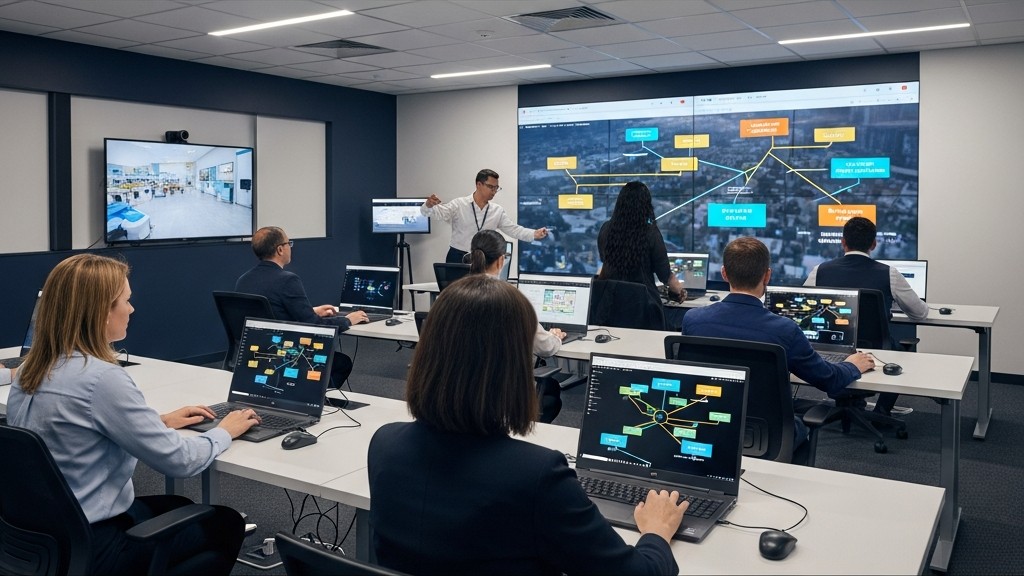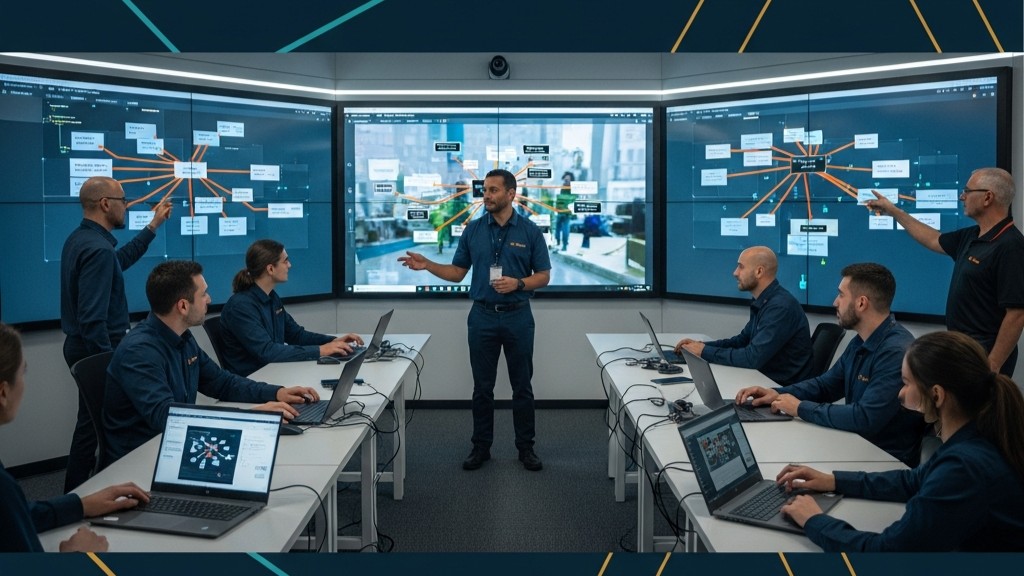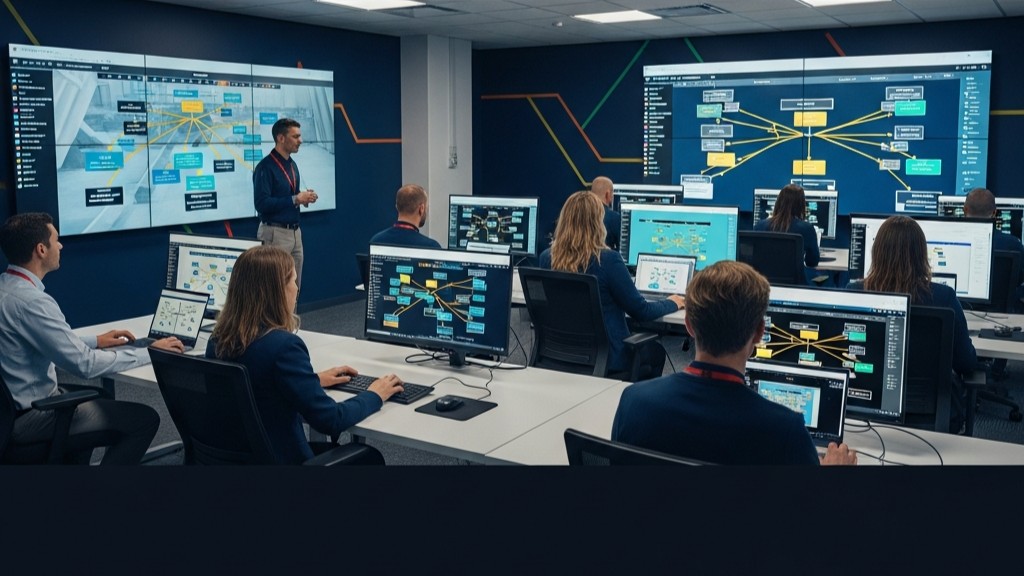What is scenario-based training?

Scenario-based training lets teams learn by doing. It immerses participants in a realistic, simulated environment where they can learn and develop, without real-world consequences. As an evidence-based form of active learning, scenario-based training helps ensure preparedness.
Read on as we cover scenario-based training’s key features, use cases, and implementation best practices.
Key features of scenario-based training
Scenario-based training is an active learning approach where participants practice skills in realistic, simulated environments that mirror real-world conditions. It allows learners to make decisions, solve problems, and experience consequences in a safe, controlled setting, which boosts engagement, confidence, and knowledge retention without real-world risk.
While basic approaches are useful for awareness and foundational skills, advanced scenario-based training platforms provide the highest realism and interactivity, delivering the most effective outcomes for preparedness and performance.
Scenario-based learning platforms make it easy to create customizable, realistic training simulations—ones that are immersive, role-specific, data‑driven, and agile. By extension, they simplify compliance, performance evaluation, and preparedness for simple and complex risks alike.
How to create an effective scenario-based learning experience
The four steps below outline a structured approach to designing and implementing a scenario-based training program.
Step 1: Analyze needs and objectives
Begin by defining the aim and objectives of the scenario-based training. These objectives may stem from specific regulatory obligations. Or, you may derive them from pre-identified performance gaps, insights from recent risk assessments, or broader organizational priorities.
Regardless of your purpose for conducting scenario-based training, set measurable success criteria for each objective. Here are some guidelines:
Aim
Write one or two clear sentences that capture the overall purpose.
Focus on what the exercise is trying to achieve (e.g. test a plan, practice coordination).
Keep it broad but meaningful.
Objectives
Use 3–5 specific, focused points.
Start each with an action verb (e.g. assess, validate, improve).
Make them SMART (Specific, Measurable, Achievable, Relevant, Time-bound).
Align with the scenario and participants’ roles.
Ensure they can be observed and evaluated during the exercise.
TTX software can help you track these criteria and link them to objectives, simplifying exercise evaluation and reporting.
Step 2: Design realistic, interactive scenarios
Next, design customized and interactive scenarios that mirror real-world incidents. In practice, this means:
Ensuring you select a scenario topic that allows each objective to be met through a progression of unfolding events.
Planning moments in the scenario where each objective can be observed, either directly by an observer during the exercise, or later by an evaluator reviewing the exercise recordings or post-exercise reports.
Fortunately, tabletop-based scenario training platforms, like Avalanche TTX, make this easy. With Avalanche TTX, administrators can seamlessly insert role-, location-, and threat-specific injects.
They can also adjust or add injects during the exercise with live-edit controls, allowing dynamic scenarios that allow participants to experience different consequences based on their decisions.
This significantly increases learner engagement and preparedness, as each inject exposes members to the same uncertainties they’ll face in real crises. Or, as one Avalanche TTX user put it, the solution helps them to “present realistic scenarios that deliver meaningful outcomes to participants.”
Step 3: Develop feedback mechanisms
Ensure that participant feedback is timely, backed by data, and actionable.
In practice, this entails:
Tracking every participant’s action against predefined objectives and success criteria.
Generating personalized feedback reports for each role, highlighting specific actions taken and opportunities missed.
Providing instant visual timelines showing decision points, actions, and their consequences during the learning process.
Enabling facilitators or evaluators to easily annotate specific moments with observations or suggestions directly on the exercise timeline.
Compiling individual and team performance trends to tailor future training programs and track lessons learned.
Step 4: Evaluate and iterate
Ensuring that each participant’s feedback is timely, backed by data, and actionable further entails facilitating structured debriefs. This is where participants review key decisions, assess the rationale behind them, and agree on targeted refinements to strengthen future contingency plans.
Let these debriefs help you refine future scenario-based training initiatives. Leverage the auto-generated after-action report as your primary source of truth, applying its exercise insights to update inject scripts, revise success thresholds, evolve processes and procedures and clarify role responsibilities.
Scenario-based training: 4 use cases
The overarching purpose of scenario-based learning is to strengthen your teams’ readiness by immersing them in realistic scenarios.
This can apply to a wide variety of incidents, including:
Data breaches: The average cost of a data breach in the U.S. is $9.36 million, not including reputational and regulatory damages. Scenario-based training mitigates these risks by stress-testing detection, containment, and communications processes within a safe, simulated environment.
Utility outages: Scenario-based exercises guide stakeholders through generator failover, manual load-shedding, escalation protocols, and other critical continuity procedures.
Natural disasters: Natural disaster contingency plans are generally broad in scope, covering everything from short-term evacuation routes to long-term recovery operations. Scenario-based training lets key stakeholders validate end-to-end response strategies and cross-functional coordination in a realistic, consequence-free setting.
Supply-chain disruptions: Scenario-based training lets key stakeholders step through the end-to-end supply chain failure lifecycle, from disruption detection and risk assessment to alternate-sourcing activation and customer communication.
Access customizable, industry-leading scenario-based training solutions
Real-time role-based scenario-training platforms like Avalanche ST, make designing, creating, and deploying customized scenario-based training exercises easy. Avalanche ST lets your staff train and develop within a realistic simulated environment, far transcending traditional e-learning methodologies.
Ensure your teams’ preparedness. Learn more about Avalanche ST.
FAQ
What is scenario-based training?
Scenario-based training places trainees in a simulated, realistic crisis situation that requires active decision-making. It allows them to practice and learn from mistakes within a safe environment.
What is an example of scenario-based learning?
Because of the highly consequential and common nature of cyberattacks, businesses commonly simulate data breach scenarios.
This involves rehearsing:
Detection and containment procedures.
Internal escalation and coordination.
Legal and regulatory notifications.
Customer and media communications.
Forensic investigation and root-cause analysis.
Post-incident recovery.
What are the benefits of scenario-based learning?
Scenario-based learning’s primary benefit is safely bridging the gap between theoretical knowledge and real-world performance. Teams that train within a safe but highly realistic environment are better prepared to mitigate high-risk incidents.
Other reasons businesses adopt scenario-based training include meeting regulatory requirements, validating response plans, and collecting objective performance metrics for continuous improvement.


